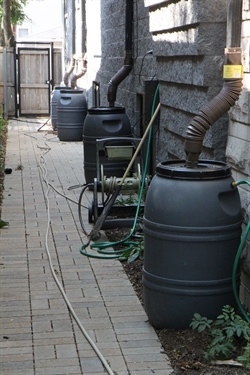
MPC
Private property green infrastructure projects, like this one in Logan Square, help reduce the strain on our sewer systems during storms.
Next time it rains—and it’s officially spring in Chicago, so you shouldn’t have to wait long—consider where all those drops of water flow. In large, older cities like Chicago, rain generally falls on a private landowner’s property—someone’s backyard or on the roof of a local business—then drains off and is collected into storm sewers owned and maintained by the local municipality. There it sometimes mixes with wastewater from individual buildings, and then eventually is treated by a wastewater utility or directed into nearby streams.
What does this mean for communities and other entities that own local sewers and treat stormwater? Well, they end up being responsible for dealing with a lot of rain that did not initially fall on property they can control. They can make stormwater improvements on their own publicly owned land; they can partner with other public entities, like schools, park districts and forest preserves; but at some point, they will have to work with private landowners. And the best way to do that is still an open question.

Many communities require downspouts to be disconnected from the sewer system.
MPC
It’s not as simple as just creating regulations that require property owners to do X to stop Y. One way to alleviate pressure on local storm sewers is to disconnect downspouts from the sewer and redirect the water to a garden, lawn or rain barrel. Doing this prevents the relatively clean water that falls on the roof from overwhelming storm sewers. And yet, while many communities require property owners to disconnect their downspouts, enforcement is difficult.
So, communities and utilities develop programs, from education and outreach to financial incentives, to encourage private property owners to participate as part of the solution. Other government agencies get into the act, as well. For example, the Illinois Environmental Protection Agency runs the Illinois Green Infrastructure Grant (IGIG). Currently in its fourth and last year, IGIG distributed $5 million annually to fund green infrastructure projects in urban areas throughout the state.
Testing a theory on funding private property green infrastructure
In the first round of IGIG awards, the Metropolitan Planning Council (MPC), in partnership with the City of Chicago, Alderman Rey Colón of the 35th Ward and the Chicago Community Loan Fund, was awarded $200,000 for the Milwaukee Avenue Green Development Corridor in Logan Square. The theory was that concentrating grant funding within one neighborhood would provide more beneficial stormwater impacts than spreading it out throughout the entire city. And by specifically targeting businesses and residences and following up with them during and after installation, the project would encourage people to install green infrastructure who might not otherwise do it.
A little over two years into the Milwaukee Avenue grant process, all of the money has been allocated, leveraging an additional $66,000 for projects ranging from rain barrel installation to backyard rain gardens to green roofs. Five projects have been installed, capturing a total of 3,996 gallons of water in a 1” storm, and another dozen or so are waiting on this spring for installation.
How best to encourage individual action for collective benefit?
As the Milwaukee Avenue project draws to a close, MPC is assessing whether a strategy like this is an effective use of the limited dollars available for stormwater solutions. While the project has provided substantial stormwater relief to the handful of properties that received the grants, the costs may have outweighed the larger-scale benefits to the sewershed.
One fundamental question that should be asked in considering any stormwater solution is, What is the goal? There are many different types of stormwater problems, from basement backups and flooding to water quality issues, and just as many solutions. Then there’s the question of whose goal is it? For the municipality or utility, it may be meeting regulatory requirements or resolving collective flooding issues. But for the individual property owner, the goal may be to relieve basement backups or just do something “green.”
Acknowledging that individual landowners may not be motivated to spend money and effort on what they see as intangible goals means communicating with them about stormwater solutions in a way that addresses their concerns. Until communications around the Milwaukee Avenue Corridor stopped focusing on “stormwater solutions” and started emphasizing “landscape improvements,” local property owners had little interest in participating.
Plenty of research exists to refine and improve both grey and green stormwater technologies, but a critical component that requires more research is the people factor. Prompted by the lessons from the Milwaukee Avenue experiment and looking into other incentive strategies around the country, such as rebates, grants, stormwater utility fee credits and more, MPC is researching how best to make people a part of the collective solution.
A longer version of this post originally appeared in Storm Water Solutions.